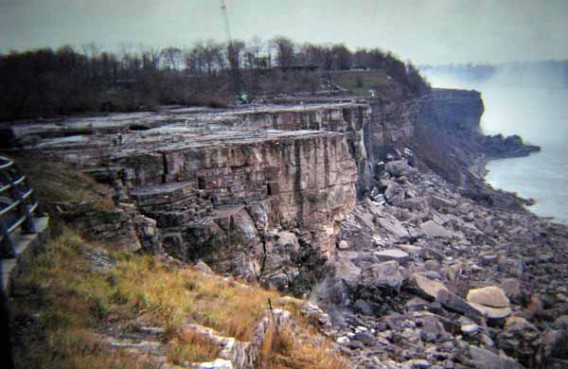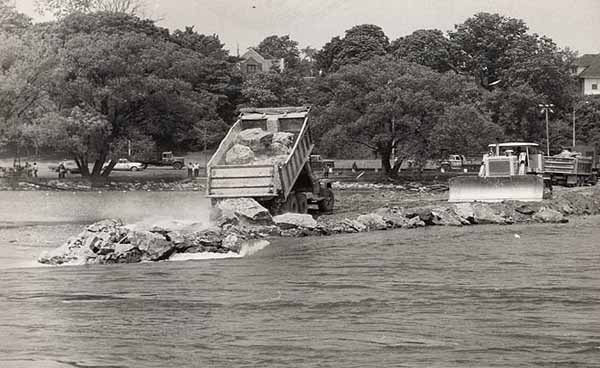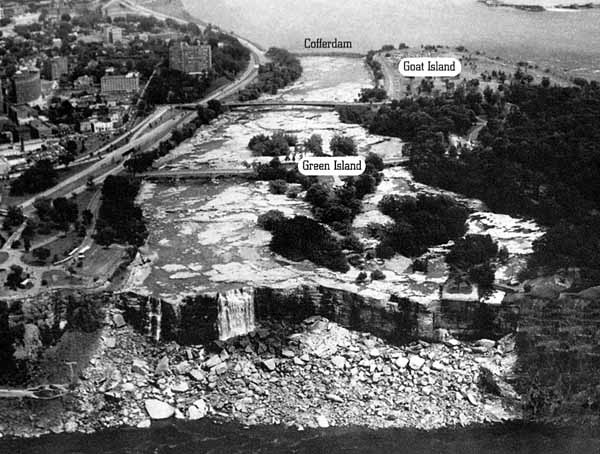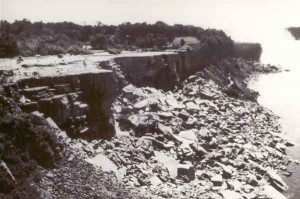- Home
- Niagara Falls Hotels
- Restaurants
- Casinos
- Niagara Falls Shut Off
- Niagara Falls USA
- Aquarium of Niagara Falls
- Goat Island
- Lewiston
- Lockport Caves
- Niagara Falls Cave of the Winds
- Niagara Falls Culinary Institute
- Fashion Outlets of Niagara Falls
- Niagara Falls Observation Tower
- Niagara Falls State Park
- Niagara Fishery
- Niagara Gorge Discovery Center
- Niagara Power Vista
- Maid of the Mist
- Oakwood Cemetery
- Old Fort Niagara
- Rainbow Bridge
- Niagara Falls Canada
- Daredevils
- Links
Niagara Falls News
Niagara Falls Went Dry in 69′

Niagara Falls Dry in 1969
Niagara Falls has flowed for over 12,000 years and except for a few severe winter ice jams over those years that created the illusion of a “frozen Falls” the water has always flowed. That is until June 12th, 1969 when the American Falls actually did go dry.
The American Falls had suffered a series of rock slides in the fifties and sixties and face of the Falls had become cluttered with huge boulders at the base. Geologists knew that Falls had been eroding and that originally they were about twelve miles down river where Lewiston New York is today.
Niagara Falls cascades over two different types of rock, shale and limestone. The limestone is below the shale and is a softer rock. The force of the water falling over 150 feet erodes the softer limestone at the base of the Falls and the heavier shale collapses from the top. This process has taken place over the last 12,00 years and is why the Falls will eventually erode into a long series of descending rapids.
 So, in 1969, after those series of rock slides the Army Corp of Engineers decided to study the issue to see if the erosion could be controlled. The Engineers constructed a cofferdam between Goat Island and the northern Niagara River shore to shut off the American Falls. The cofferdam was constructed with almost 28,000 tons of rock and on June 12, 1969 the American Falls were shut off.
So, in 1969, after those series of rock slides the Army Corp of Engineers decided to study the issue to see if the erosion could be controlled. The Engineers constructed a cofferdam between Goat Island and the northern Niagara River shore to shut off the American Falls. The cofferdam was constructed with almost 28,000 tons of rock and on June 12, 1969 the American Falls were shut off.
 The “Dry Falls” became a tourist attraction in their own right and millions of visitors traveled to Niagara Falls to see something that no generation had seen before. Over the next six months the Engineers drilled and studied the American Falls rock bed to determine if it could be strengthened and the boulders removed.
The “Dry Falls” became a tourist attraction in their own right and millions of visitors traveled to Niagara Falls to see something that no generation had seen before. Over the next six months the Engineers drilled and studied the American Falls rock bed to determine if it could be strengthened and the boulders removed.
Finally it was decided that the huge mound of boulders at the base of the Falls were in part holding up the cliff face. So the Engineers decided to do some “minor” reconstruction and securing of the rock bed.
Instruments were installed on Prospect Point, Luna Island and Terrapin Point to monitor future rock movements which Engineers knew was inevitable. Huge steel dowels and cable tendons were drilled into the rock bed in a series of patterns at Luna Island and the Bridal Veil Falls to solidify and stabilize the rocks as much as possible. Drainage holes were drilled into the Limestone at the American Falls, the Bridal Veil Falls and Terrapin Point to relieve the hydrostatic pressure.
 The boulders at the base of the American Falls were left . It was decided that to remove the talus would be too expensive and create too much of an artificial look. The water flowing over the American Falls is too little to erode the debris so it was left untouched. On November 25th 1969 the Engineers removed the cofferdam and the American Falls came back to life.
The boulders at the base of the American Falls were left . It was decided that to remove the talus would be too expensive and create too much of an artificial look. The water flowing over the American Falls is too little to erode the debris so it was left untouched. On November 25th 1969 the Engineers removed the cofferdam and the American Falls came back to life.
Prior to this remediation the American Falls were eroding at a rate of five feet a year. Now because of increased water diversion and the anti-erosion efforts the American Falls is receding at only 3 – 4 inches every 10 years. The water flow which has been regulated by both the American and Canadian Hydro Electric plants is insufficient to cause major erosion. The look of the American Falls will now be preserved throughout our lifetime.








